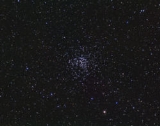
Messier 37
Encyclopedia
Messier 37 is the richest open cluster
in the constellation
Auriga
. It was discovered by Hodierna
before 1654.
Messier
37 is the brightest of the three open clusters in Auriga. M37 was missed by Le Gentil when he rediscovered M36
and M38
in 1749. Charles Messier
independently rediscovered M37 in September of 1764 but all three clusters were recorded by Hodierna before 1654.
M37 is roughly 300 million years old and contains over 500 stars with roughly 150 stars brighter than magnitude
12.5. M37 also contains at least a dozen red giants with the hottest main sequence
star of spectral type B9V. Its distance is between 3,600 to 4,700 light years
and the apparent diameter of 24' corresponds to a linear extension of about 20 to 25 light years. It is classified as Trumpler
type I,1,r or I,2,r.
Open cluster
An open cluster is a group of up to a few thousand stars that were formed from the same giant molecular cloud and have roughly the same age. More than 1,100 open clusters have been discovered within the Milky Way Galaxy, and many more are thought to exist...
in the constellation
Constellation
In modern astronomy, a constellation is an internationally defined area of the celestial sphere. These areas are grouped around asterisms, patterns formed by prominent stars within apparent proximity to one another on Earth's night sky....
Auriga
Auriga (constellation)
Auriga is a constellation in the northern sky. Its name is Latin for 'charioteer' and its stars form a shape that has been associated with the pointed helmet of a charioteer. It was one of the 48 constellations listed by the 2nd century astronomer Ptolemy, and remains among the 88 modern...
. It was discovered by Hodierna
Giovanni Battista Hodierna
Giovanni Battista Hodierna was an Italian astronomer at the court of the Duke of Montechiaro. He compiled a catalog of some 40 entries, including at least 19 real and verifiable nebulous objects that might be confused with comets. The work anticipated Messier's catalogue, but had little impact...
before 1654.
Messier
Messier object
The Messier objects are a set of astronomical objects first listed by French astronomer Charles Messier in 1771. The original motivation of the catalogue was that Messier was a comet hunter, and was frustrated by objects which resembled but were not comets...
37 is the brightest of the three open clusters in Auriga. M37 was missed by Le Gentil when he rediscovered M36
Messier 36
Open Cluster M36 is an open cluster in the Auriga constellation. It was discovered by Giovanni Batista Hodierna before 1654. M36 is at a distance of about 4,100 light years away from Earth and is about 14 light years across. There are at least sixty members in the cluster...
and M38
Messier 38
Messier 38 is an open cluster in the Auriga constellation.It was discovered by Giovanni Batista Hodierna before 1654 and independently found by Le Gentil in 1749...
in 1749. Charles Messier
Charles Messier
Charles Messier was a French astronomer most notable for publishing an astronomical catalogue consisting of deep sky objects such as nebulae and star clusters that came to be known as the 110 "Messier objects"...
independently rediscovered M37 in September of 1764 but all three clusters were recorded by Hodierna before 1654.
M37 is roughly 300 million years old and contains over 500 stars with roughly 150 stars brighter than magnitude
Apparent magnitude
The apparent magnitude of a celestial body is a measure of its brightness as seen by an observer on Earth, adjusted to the value it would have in the absence of the atmosphere...
12.5. M37 also contains at least a dozen red giants with the hottest main sequence
Main sequence
The main sequence is a continuous and distinctive band of stars that appears on plots of stellar color versus brightness. These color-magnitude plots are known as Hertzsprung–Russell diagrams after their co-developers, Ejnar Hertzsprung and Henry Norris Russell...
star of spectral type B9V. Its distance is between 3,600 to 4,700 light years
Light Years
Light Years is the seventh studio album by Australian recording artist Kylie Minogue. It was released on 25 September 2000 by Parlophone and Mushroom Records. The album's style was indicative of her return to "mainstream pop dance tunes"....
and the apparent diameter of 24' corresponds to a linear extension of about 20 to 25 light years. It is classified as Trumpler
Robert Julius Trumpler
Robert Julius Trumpler was a Swiss-American astronomer....
type I,1,r or I,2,r.

